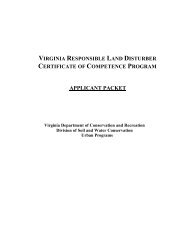Appendix 4-A - Virginia Department of Conservation and Recreation ...
Appendix 4-A - Virginia Department of Conservation and Recreation ...
Appendix 4-A - Virginia Department of Conservation and Recreation ...
Create successful ePaper yourself
Turn your PDF publications into a flip-book with our unique Google optimized e-Paper software.
(DCR199-196) (10/10)<br />
Excerpt from DCR <strong>Recreation</strong>al Trails Program<br />
Resource Agency Coordination <strong>and</strong> Environmental Screening Forms<br />
This portion <strong>of</strong> the PDESA is a working tool used to identify the potential impact to the environment<br />
as a result <strong>of</strong> the proposed trail project. By completing the ESF, the project sponsor is providing<br />
information that will support the proposal:<br />
1. meets criteria to be categorically excluded (CE) from further NEPA or<br />
2. requires further analysis through an environmental assessment (EA) or an environmental<br />
impact statement (EIS).<br />
An ESF alone does not constitute adequate environmental documentation unless a CE is<br />
recommended. If an EA is required, the EA process <strong>and</strong> resulting documents must be developed for<br />
further consideration for approval by the FHWA. If an EIS is needed, DCR <strong>and</strong> FHWA will<br />
determine the appropriate steps on how to proceed.<br />
The ESF contains two parts that must be completed:<br />
Part A. Environmental Resources Part B. M<strong>and</strong>atory Criteria<br />
Part A: For each environmental resource topic, choose an impact estimate level (none, negligible,<br />
minor, exceeds minor) that describes the degree <strong>of</strong> potential negative impact for each listed resource<br />
that may occur directly, indirectly <strong>and</strong> cumulatively as a result <strong>of</strong> federal approval <strong>of</strong> your proposal.<br />
For each impacted resource provide a brief explanation <strong>of</strong> how the resource will be affected, how<br />
the impact level was determined, <strong>and</strong> why the chosen impact level is appropriate. For impacted<br />
resources describe planned mitigation for each applicable resource, <strong>and</strong> choose an impact level as<br />
mitigated. If the resource does not apply to your proposal, mark NA in the first column. Add any<br />
relevant resources (see A.24 on the ESF) if not included in the list.<br />
Part B: This is a list <strong>of</strong> m<strong>and</strong>atory impact criteria that preclude the use <strong>of</strong> categorical exclusions. If<br />
you answer “yes” or “maybe” for any <strong>of</strong> the m<strong>and</strong>atory criteria you must contact DCR for<br />
consultation.<br />
Division <strong>of</strong> Natural Heritage<br />
The Division <strong>of</strong> Natural Heritage (DNH) has instructions posted online for obtaining comments at<br />
www.dcr.virginia.gov/natural_heritage/infoservices.shtml#er.<br />
In general, DNH will need a project description, a USGS topographic map with the project boundaries<br />
clearly delineated <strong>and</strong> a completed information services order form. The order form is available on the<br />
DNH website. For specific questions, please contact Rene’ Hypes, Information Services Manager, at<br />
804.371.2708.
















